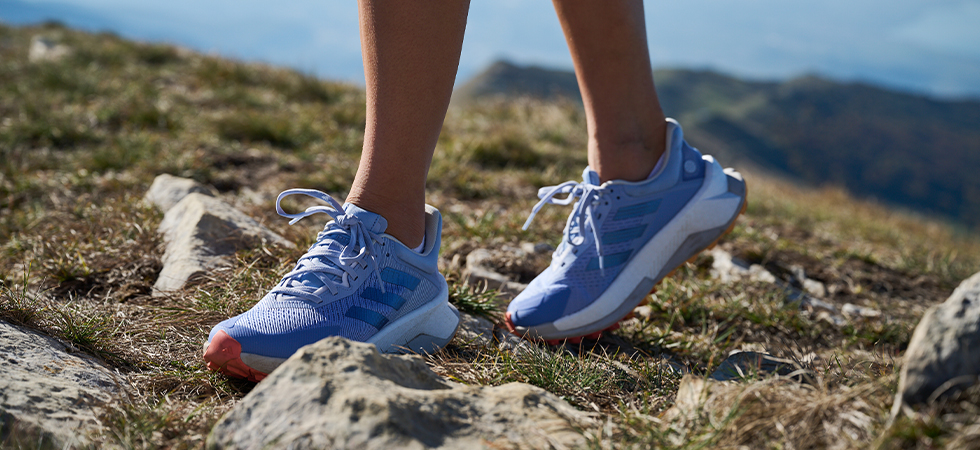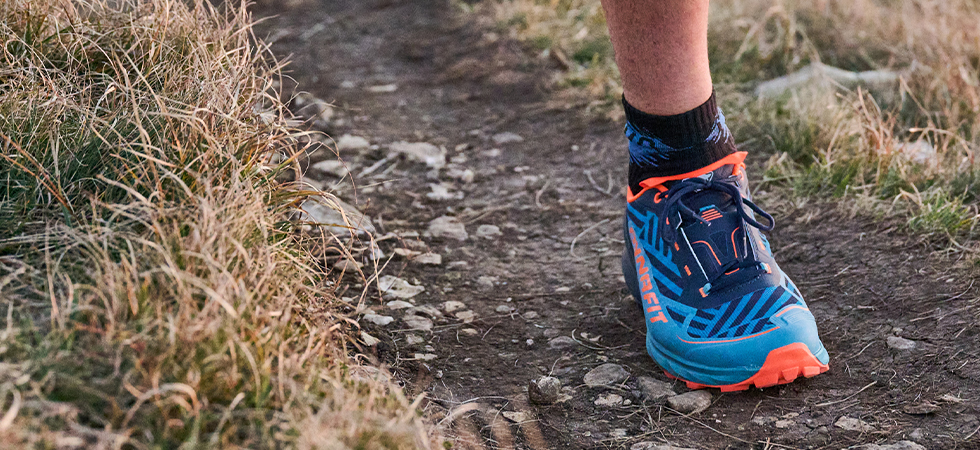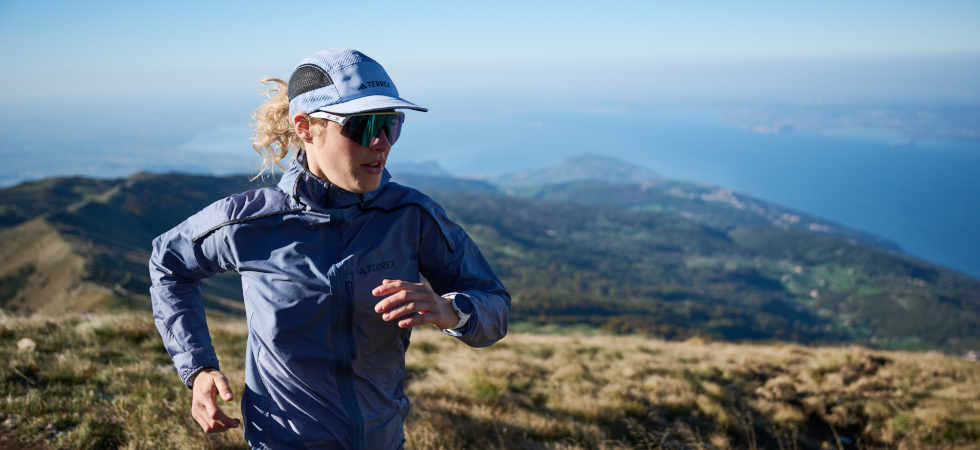Whether on the trail, climbing the mountains or on rough terrain in the forest – your trail running shoe must withstand extreme loads. So that you can get the best performance out of yourself when running off-road, the right shoe is the key. Trail running shoes have to withstand a lot more than an ordinary running shoe: more extreme terrain and also more extreme conditions. The trail running shoe must not only provide runners with appropriate support and safety on soft, rocky, uneven or slippery surfaces, but also offer a certain level of running comfort away from paved roads. After all, trail running, like any other sport, should be fun and relaxing.
With unsuitable shoes, however, the endurance sport can quickly become a torment. Twisted ankles, aching soles, wet feet and falls – all things that can be prevented with the right footwear. In our ABC of trail shoes, we help you choose your next shoe. In the guide, we tell you what you should look for when choosing the right trail running shoe, which features are crucial, and which shoes you need for which area of use. We are sure: Your next shoe will be your perfect partner off the road.

The most important feature of trail running shoes at a glance
To be able to run cross-country, up, down, and literally over hill and dale, your trail running shoes need certain characteristics. These do not only include safety, stability, and comfort as mentioned above, but also the right cushioning and the right material.
Safety & Grip in rough terrain
To ensure safety and grip in the terrain, the sole and the profile of the trail running shoes play a decisive role. The sole is generally stiffer than the one of normal running shoes and can, therefore, be less twisted. This is an important point, especially on trails with many stones or soft ground. To protect against sharp stones or other bumps a good midsole is also crucial. In addition, the toes are protected from shocks by a rubber or leather cap.
The profile of trail running shoes is coarse and deep and is characterized by lamellae, ribs, nubs, or studs – depending on the manufacturer. This ensures not only better power transmission and running dynamics in rough terrain but also a better grip on dry ground. In wet or icy conditions, however, there is a risk of slipping due to the reduced contact area. This is counteracted by special rubber compounds.
The drop, i.e. the difference in height between the forefoot and the heel, should be rather low in trail running shoes. Usually the value is about 4 mm. This low drop ensures that you always have good contact with the ground on difficult trails. In addition, you have more feeling in the shoe, which also provides more safety.

Stability: Free movement with Twist Protection
For stability in the terrain, a good heel hold is essential. It helps to control landings better and to prevent twisting your ankle. To ensure protection against twisting, the sole construction under the heel is also wider cut than in ordinary running shoes, and the center of gravity is lowered, to allow more direct contact with the ground.
Overall, it is very important that the shoe provides excellent support in the ankle area. At the same time, however, it must not be cut too high, since you need freedom of movement during trail running.
Comfort: Not too loose nor too tight
As with any other shoe, trail running shoes are all about comfort. Only comfortable shoes are good trail running shoes that are perfect for your feet and for you. Since trail running includes a lot of downhill running, it is especially important that your toes have enough space and do not hit the front.
In addition to the right size, the right fit is crucial. The trail shoe must not be too loose or too tight. However, there is no magic formula, it is best to try a few different models and to get yourself some expert advice.

Cushioning: Right Damping for all Surfaces
Cushioning plays a much smaller role in trail running than it does in traditional running. Since you rarely run on asphalt during trail running, the shoes are only minimally damped. This allows you to run much better on the ever-changing surfaces, such as forest soil, rocks, ice, snow, or sand.
The damping used varies from manufacturer to manufacturer, ranging from foam to gel or air cushioning.
Material: Robust but Breathable or Waterproof?
Since trail running shoes are much more stressed in the terrain than normal sports shoes, the upper material must be a lot more robust. It protects your feet from sharp objects like stones or thorns. The toes are, as already mentioned, additionally protected by a cap made of rubber or leather.
Essential for trail running shoes is breathable material. Of course, there are also situations in which you need a waterproof shoe with a Goretex membrane, but these are rather the exception – for beginners such shoes are therefore not absolutely necessary. Trail running pros usually have at least two different pairs of shoes: a waterproof one for colder and wet seasons and a breathable one for the warmer, drier months.

different shoes for different feet and trail running styles
When choosing the right shoes, it is not only about the features just mentioned. Your feet, your skills, and your goals as well play an important role. Depending on the model, the weight, sole and midsole, drop and fit of the shoe differ.
The right shoe for your foot
Every foot is different and therefore not every shoe fits equally well to every runner. As with the purchase of running shoes, your foot position, which in turn affects your running style, is crucial. It is especially important how the foot turns while running – in other words, which pronation type you are. Runners with neutral pronation, have no special feature and therefore have the largest selection of trail running shoes available.
However, if you have an overpronation or underpronation, it must be balanced with a corresponding shoe. While the foot of runners with overpronation turns more inward, the foot of runners with underpronation strikes the ground more intensely turned outwards. If these misalignments are not counteracted incorrectly, the wrong stress also has negative consequences for your knees and hips.
If you are not sure which pronation type you are and which shoes you need, it is best to get some advice from our experts. In our stores in Penzberg, Garmisch-Partenkirchen, and Wielenbach possible malpositions can be determined immediately and the perfect shoe can be found.

The 4 types of trail running and the matching shoes
Trail running is often divided into four different types based on the type of terrain, intensity, and speed: cross running, cross trail, cross adventure, and cross speed. For each of these types, different trail running shoes are best suitable.
For many beginners cross running is the start into trail running. “From door to trail” is the motto here, meaning that the run begins at your front door. Since the trail, however, usually does not start right at your own home, it means running a few kilometers on asphalt before it goes into the terrain. The trail running shoes must therefore be suitable for both the city and for running in nature. You need shoes that have good cushioning and a little more profile than running shoes. Stability is not so much important in this case.
Find out more about trail running in the city in our “Urban Trailrunning” Guide.
Cross trail is the original form of trail running. It is about running completely off the paved roads, on prepared trails in nature. This type of trail running is also ideal for beginners – especially for outdoor fans who want to practice their sport 100% in nature. In contrast, to cross running the stability of the shoes needs to be given as well as an increased damping and a medium profile.
Cross adventure is a slightly more demanding form of trail running and is therefore suitable for advanced runners as well as professionals. The venue is the alpine terrain, through which the runners make their way across natural obstacles. The unpaved roads require the highest concentration to avoid injury. Trail running shoes for cross adventure must be characterized by a strong profile and high stability. Cushioning is rather counterproductive since the power transmission gets spongy.
Cross speed is the master class of trail running. Here it comes in the context of competitions therefore as fast as possible to the goal to come. Since the high speed often does not leave the time to choose every step, the very high stability of the shoes is essential. Similarly, a strong profile for better grip and good power transmission is needed. Trail running shoes for this discipline are also characterized by a low weight and a precise fit.

Various Manufacturers and their special features
In addition to the various features and applications of trail running shoes, there are of course also differences depending on the manufacturer. It can not be said which manufacturer is most suitable for which runner – this depends entirely on your personal preferences. However, if you have already made good experiences with certain brands from your running experience, it is also worthwhile to take a closer look at the trail running shoes of these manufacturers.
In order to get an idea of what distinguishes the different manufacturers of trail running shoes, we have listed the most important features for you:
The Quicklace system by Salomon and their division S/LAB is probably one of the most popular inventions in the trail running area. It is a quick lacing system that allows you to “lace” the shoes in a matter of seconds with just one pull, thus distributing the pressure ideally on the whole foot. The strap can then be conveniently stored in a small bag at the top of the tongue. As a result, the laces can not unintentionally open and also do not get caught on branches or scrub. The Quicklace system is used in a slightly modified form by other manufacturers as well, such as Dynafit, La Sportiva, and Adidas.
Another lacing system that is sometimes used for trail running shoes is the so-called Boa system, which is known as snowboard boots. The principle is similar to the Salomon Quicklace system, but the shoelace is not drawn by hand, but with the help of a wheel. By simply pulling up the wheel, the strap is released again. Find out more about the system through our Boa article.
With its extremely thick sole Hoka stands out when it comes to cushioning and flex, La Sportiva offers different rubber compounds to fit different applications, and depending on the manufacturer, there are also shoes with an integrated gaiter. These include, for example, La Sportiva and Salomon.
At Sport Conrad you will find a wide range of different trail running shoes for women, men and children. With a little luck, you’ll find your perfect model that will protect and support you during off-road runs.
We have also already tested selected trail running shoes:
Dynafit trail running shoes – Find the perfect trail companion
Gear review: The S/Lab Ultra 3 – Your new running buddy
Gear Review: Dynafit Alpine DNA Trailrunning shoe
Read other interesting blog posts about trail running:
→ Trailrunning rule book: What is there to know
→ Trailrunning backpack and hip bag guide
→ How LEKI turned poles into a must-have in trail running






